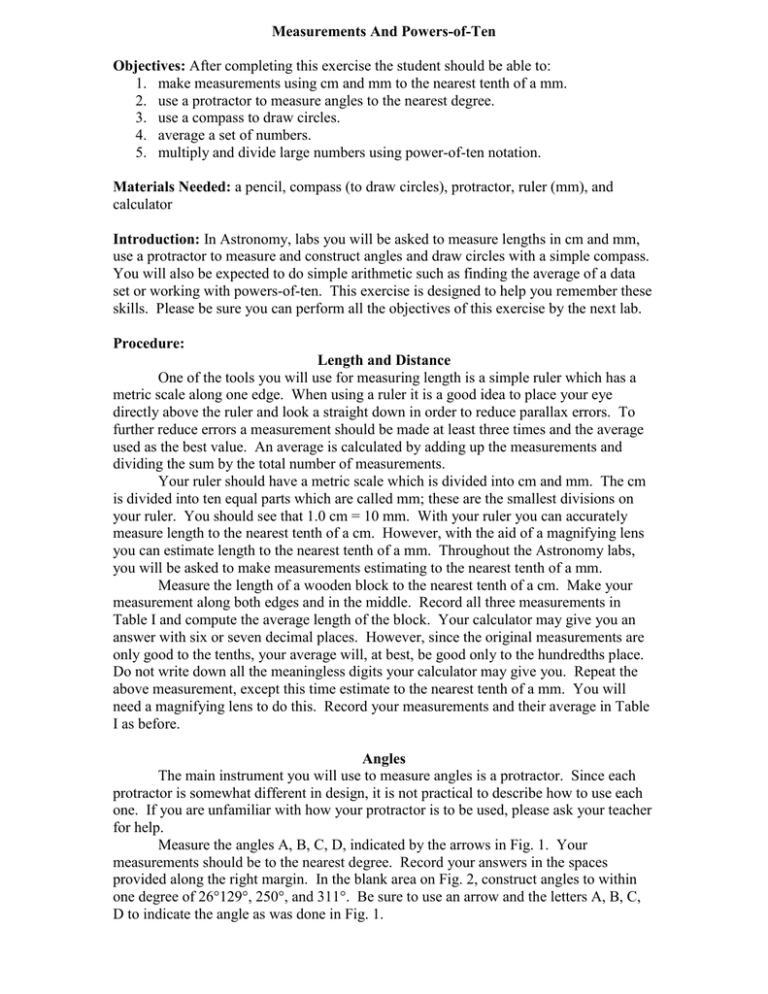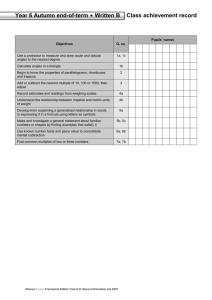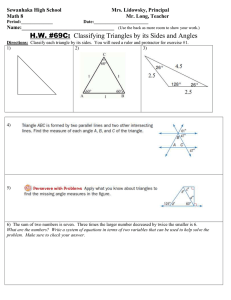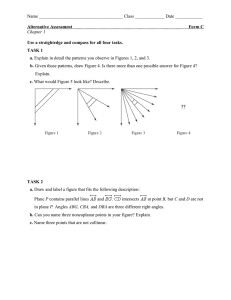Measurements And Powers-of-Ten Objectives:
advertisement

Measurements And Powers-of-Ten Objectives: After completing this exercise the student should be able to: 1. make measurements using cm and mm to the nearest tenth of a mm. 2. use a protractor to measure angles to the nearest degree. 3. use a compass to draw circles. 4. average a set of numbers. 5. multiply and divide large numbers using power-of-ten notation. Materials Needed: a pencil, compass (to draw circles), protractor, ruler (mm), and calculator Introduction: In Astronomy, labs you will be asked to measure lengths in cm and mm, use a protractor to measure and construct angles and draw circles with a simple compass. You will also be expected to do simple arithmetic such as finding the average of a data set or working with powers-of-ten. This exercise is designed to help you remember these skills. Please be sure you can perform all the objectives of this exercise by the next lab. Procedure: Length and Distance One of the tools you will use for measuring length is a simple ruler which has a metric scale along one edge. When using a ruler it is a good idea to place your eye directly above the ruler and look a straight down in order to reduce parallax errors. To further reduce errors a measurement should be made at least three times and the average used as the best value. An average is calculated by adding up the measurements and dividing the sum by the total number of measurements. Your ruler should have a metric scale which is divided into cm and mm. The cm is divided into ten equal parts which are called mm; these are the smallest divisions on your ruler. You should see that 1.0 cm = 10 mm. With your ruler you can accurately measure length to the nearest tenth of a cm. However, with the aid of a magnifying lens you can estimate length to the nearest tenth of a mm. Throughout the Astronomy labs, you will be asked to make measurements estimating to the nearest tenth of a mm. Measure the length of a wooden block to the nearest tenth of a cm. Make your measurement along both edges and in the middle. Record all three measurements in Table I and compute the average length of the block. Your calculator may give you an answer with six or seven decimal places. However, since the original measurements are only good to the tenths, your average will, at best, be good only to the hundredths place. Do not write down all the meaningless digits your calculator may give you. Repeat the above measurement, except this time estimate to the nearest tenth of a mm. You will need a magnifying lens to do this. Record your measurements and their average in Table I as before. Angles The main instrument you will use to measure angles is a protractor. Since each protractor is somewhat different in design, it is not practical to describe how to use each one. If you are unfamiliar with how your protractor is to be used, please ask your teacher for help. Measure the angles A, B, C, D, indicated by the arrows in Fig. 1. Your measurements should be to the nearest degree. Record your answers in the spaces provided along the right margin. In the blank area on Fig. 2, construct angles to within one degree of 26°129°, 250°, and 311°. Be sure to use an arrow and the letters A, B, C, D to indicate the angle as was done in Fig. 1. A Scale Drawing of the Solar System Drawing planetary orbits is a very important part of this chapter. Most planetary orbits can be approximated using an off-center circle. In order to practice drawing circles you will make two scale drawings of the solar system. One drawing will be for the inner planets and the other one will be for the outer planets. A compass is used to draw circles. The compass point and the pencil tip should be separated a distance equal to the radius of the circle you wish to construct. This is best done by placing the compass point and pencil tip along the edge of a ruler and opening the compass to the desired amount using the ruler’s scale. Do not use the scale on the compass itself because these scales are not accurate. The distance between the Earth and sun is called an astronomical unit (AU). In Table II and III a list of planers and their distances from the sun in AU’s is given. Note that two different scales have to be used because the outer planets are significantly father from the sun than the inner planets. For continuity, Jupiter is repeated in both scales. Multiply each planet’s distance in AU’s by the scale factor given for each table and record your results in the last column of Tables II and III. These distances are in cm and will be used to make your scale drawing. In the center of Fig. 3 is a dot which will represent the sun. With a compass, draw circles centered on the sun which have radii equal to the scale distance of Mercury through Jupiter as listed in the first part of Table II. Label each circle by the name of the planet whose orbit it represents. You have completes a scale drawing of the inner planers and one outer planet, Jupiter. Notice that a rather large gap exists between Mars and Jupiter. It is known to be filled with thousands of small rocks called asteroids. On your model, label this gap as the asteroid belt. In the center of Fig. 4 is a dot that represents the sun. With a compass draw circles centered on the sun which have radii equal to the scale distances of Jupiter through Neptune, as listed in Table III. Label each circle by name of the planet whosr orbit it represents. Notice how much smaller Jupiter’s orbit is on this drawing than on the previous system onto a single page. Pluto’s orbit is so eccentric that its center is basically near the orbit of Saturn and not near the sun. Therefore place the point of your compass on Saturn’s orbit (use the side nearest the bottom of your page) and draw Pluto’s orbit with a radius equal to the scale distance in Table III. Notice that Pluto’s orit actually comes inside Neptune’s orbit. Beyond the Solar System Table IV lists several objects and their distances from the sun in AU’s. By comparing Table IV to Table II and Table III it can be seen that the objects in Table IV are outside the solar system. Compute the scale distance in cm for each object in table IV using the scale of Table II, 2.0 cm = 1 AU. To do this, multiply the AU distances in Table IV by 2.0 cm and record your results. If you do not understand how to multiply using scientific notation, please ask for help. So that you can get a better feeling for how far in miles the scale distances of Table IV are from our classroom, divide them by the conversion factor 1.6 X 105 cm/mile and record your answers using scientific notation. You might say these large numbers are astronomical. Fig. 1: Angles to be measures by students. Fig. 2: Construction of angles by students. Fig. 3: Scale Drawing of Inner Solar System Fig. 4: Scale Drawing of Outer Solar System Table I – Length of Block Trial Number Length to hundredths of a cm Length to tenths of a mm 1 2 3 Average length in cm = ___________________ Average length in mm = _____________________ Table II – Scale of Planets Scale: 2.0 cm = 1 AU Planet Distance AU Mercury 0.4 Venus 0.7 Earth 1.0 Mars 1.5 Jupiter 5.2 Scale Distance cm Table III – Scale of Planets Scale: 0.25 cm = 1 AU Planet Distance AU Jupiter 5.2 Saturn 9.6 Uranus 19.6 Neptune 30.5 Pluto 39.5 Scale Distance cm Table IV – Beyond the Solar System Scale: 2.0 cm = 1 AU Object Distance AU Alpha Centauri 2.8 X 105 Center of the Milky Way 1.6 X 109 Andromeda Galaxy (nearest spiral galaxy) 1.2 X 1011 Scale Distance Cm Scale Distance Miles


